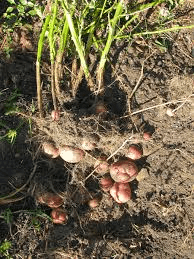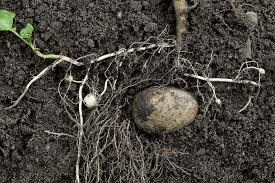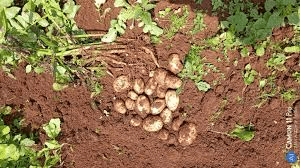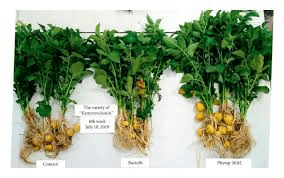Potato stolons are specialized underground stems that extend horizontally from the base of the potato plant. These stolons play a crucial role in the growth and development of potato tubers, which are the edible part of the plant. Unlike roots, stolons are stem tissues that grow underground and are integral to the potato plant’s reproductive strategy.
Stolons originate from the main stem of the potato plant, typically just below the soil surface. As the plant matures, these stolons elongate and spread out horizontally. The growth of stolons is influenced by various factors, including soil temperature, moisture levels, and the availability of nutrients. Optimal conditions for stolon development include well-drained soil, adequate irrigation, and moderate temperatures.
The formation of tubers begins at the tips of the stolons. As the stolons grow, the tips swell and develop into tubers, storing nutrients and energy for the plant. This process is called tuberization. The primary function of stolons is to support the growth of tubers, which are rich in carbohydrates, particularly starch, and serve as a food reserve for the plant. These stored nutrients can be used by the plant to survive adverse conditions and to regrow in the next growing season.
Stolons have several nodes along their length, each capable of developing into a new tuber. The nodes are also the points from which roots can emerge, anchoring the tuber in the soil and facilitating the absorption of water and nutrients. The ability of stolons to produce multiple tubers from a single plant is one of the reasons why potatoes are such an efficient and productive crop.
The length and number of stolons can vary depending on the potato variety and growing conditions. Some potato varieties are known for producing long stolons that spread widely, leading to a more extensive network of tubers. Other varieties have shorter stolons, resulting in a more compact arrangement of tubers. Farmers and gardeners often select potato varieties based on these characteristics to suit their specific growing environments and harvest preferences.
Stolons are also significant in agricultural practices, particularly in the propagation of potatoes. When planting seed potatoes, which are pieces of tubers containing at least one eye, the stolons that grow from these eyes will produce new tubers. This vegetative propagation method ensures that the genetic traits of the potato variety are maintained, allowing for the consistent reproduction of desirable characteristics such as yield, size, and resistance to pests and diseases.
However, the development of stolons and tubers can be affected by environmental stressors and diseases. Poor soil conditions, inadequate watering, and extreme temperatures can hinder stolon growth and tuber formation. Additionally, pests such as wireworms and diseases like late blight can damage stolons and reduce crop yield. Effective pest and disease management, along with optimal cultivation practices, are essential for healthy stolon development and successful potato production.
In terms of plant physiology, stolons exhibit interesting growth patterns. They grow in a negative geotropic manner, meaning they grow away from gravity. This horizontal growth allows them to spread across the soil and maximize the area for potential tuber formation. Stolons also have the ability to sense light, even underground, which can influence their growth direction.
In conclusion, potato stolons are specialized underground stems that play a vital role in the growth and reproduction of potato plants. They support the formation of tubers, which are essential for both the plant’s survival and human consumption. Understanding the growth and development of stolons is crucial for effective potato cultivation, ensuring high yields and quality crops. Proper management of environmental conditions and pests can enhance stolon growth, contributing to successful potato farming and food production.
The Economic Importance and Uses of Potato Stolons

1. Propagation: Potato stolons are critical for the propagation of potato plants. They grow underground and produce new tubers, ensuring the continuation of the crop.
2. Crop Yield: Stolons significantly influence the yield of potato crops. Healthy stolon development leads to the production of more and larger tubers.
3. Agricultural Research: Researchers study stolons to understand potato growth patterns, disease resistance, and genetic traits, which helps improve crop varieties.
4. Disease Resistance: Stolons are used in breeding programs to develop disease-resistant potato varieties, enhancing crop resilience.
5. Genetic Diversity: Through stolon propagation, different potato varieties can be maintained and developed, promoting genetic diversity within the species.
6. Sustainable Farming: Stolons enable sustainable farming practices by allowing farmers to propagate potatoes naturally, reducing the need for purchased seed tubers.
7. Soil Health: The growth of stolons improves soil structure and fertility, contributing to better soil health over time.
8. Educational Tool: Potato stolons are used in educational settings to teach students about plant biology, specifically underground growth and tuber formation.
9. Home Gardening: Home gardeners use stolons to propagate potatoes in their gardens, supporting self-sufficiency and local food production.
10. Food Security: By ensuring the propagation of potato plants, stolons contribute to food security in regions where potatoes are a staple food.
11. Rural Economy: Stolons support the rural economy by providing a reliable method for farmers to produce consistent and high-yielding potato crops.
12. Climate Adaptability: Stolons allow potatoes to be grown in a variety of climates, helping farmers adapt to changing environmental conditions.
13. Biodiversity Conservation: Stolons can be used to grow and preserve heirloom and rare potato varieties, contributing to biodiversity conservation.
14. Low-Cost Production: Growing potatoes from stolons reduces the cost of production for farmers, as they do not need to buy new seed tubers each season.
15. Organic Farming: Stolons are used in organic farming to grow potatoes without synthetic inputs, promoting environmentally friendly agriculture.
16. Community Gardening: Stolons are used in community gardens to grow potatoes, fostering community engagement and providing fresh produce to local residents.
17. Crop Rotation: Potato stolons play a role in crop rotation systems, improving soil health and reducing pest and disease buildup.
18. Renewable Resource: Stolons represent a renewable resource for potato cultivation, reducing dependency on commercial seed suppliers.
Read Also: Dragon Fruits: History, Nutrition, Health Benefits and Growing Guide
The Products and By-products That Can Be Derived From Potato Stolons

1. Seed Potatoes: Stolons produce new tubers that can be used as seed potatoes for planting future crops.
2. Potato Plants: The primary product from stolons is the potato plant itself, which produces edible tubers.
3. Mini Tubers: Small tubers produced from stolons can be used in seed production or as gourmet potatoes in niche markets.
4. Potato Vines: Vines grown from stolons can be used as animal feed or composted to enrich soil.
5. Plant Extracts: Extracts from potato plants grown from stolons can be used in various industrial and research applications.
6. Potato Flowers: Flowers from potato plants can be used in breeding programs to develop new potato varieties.
7. Potato Leaves: Leaves from potato plants can be composted or used in organic mulching systems.
8. Potato Stem: Stems from potato plants can be used in composting or as a green manure crop to improve soil health.
9. Micropropagation: Stolons can be used in tissue culture and micropropagation techniques to produce disease-free plantlets.
10. Disease-Resistant Varieties: Stolons are used in breeding programs to develop disease-resistant potato varieties.
11. Genetic Research: Stolons are used in genetic research to study plant development and disease resistance.
12. Bioengineering: Stolons can be used in bioengineering to develop potatoes with enhanced nutritional profiles or other beneficial traits.
13. Crop Improvement: Stolons are used in crop improvement programs to enhance yield, quality, and stress tolerance.
14. Agro-ecological Studies: Stolons are used in agro-ecological studies to understand interactions between potato plants and their environment.
15. Potato Biomass: Biomass from potato plants grown from stolons can be used in bioenergy production.
16. Potato-Based Biofertilizers: Residues from potato plants grown from stolons can be processed into biofertilizers.
17. Potato Cellulose: Cellulose extracted from potato plants grown from stolons can be used in food products and as a bio-based material.
Read Also: The Anise Fruits: Economic Importance, Uses, and By-Products
Frequently Asked Questions (FAQ’s) About Potato Stolons

1. What are potato stolons?
Potato stolons are underground stems that grow horizontally and produce new potato tubers.
2. How do potato stolons contribute to potato growth?
Stolons extend from the main plant and develop into new tubers, contributing to the overall yield of the potato crop.
3. Can stolons be used for planting new potatoes?
Yes, stolons can be used to grow new potato plants by planting the tubers they produce.
4. How long do stolons take to produce tubers?
Stolons typically start producing tubers within a few weeks of the potato plant’s growth, depending on the growing conditions.
5. Are potato stolons edible?
No, potato stolons themselves are not edible, but they produce tubers that are.
6. How do you encourage stolon growth in potato plants?
Proper soil preparation, adequate watering, and sufficient nutrients encourage healthy stolon growth.
7. Do all potato varieties produce stolons?
Yes, all potato varieties produce stolons as part of their natural growth process.
8. How do stolons affect potato yield?
Healthy stolon development leads to the production of more tubers, increasing the potato yield.
9. Can stolons be used in genetic research?
Yes, stolons are used in genetic research to study plant development, disease resistance, and other traits.
10. How should stolons be handled during harvesting?
Careful handling is necessary to avoid damaging the stolons and the developing tubers during harvesting.
Read Also: Chicken Brooder House – Complete Chicks Brooding Care Guide






